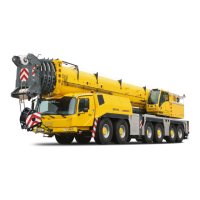GROVE 3-19
CD3340B/YB4411 ELECTRIC SYSTEM
Published 04/07/2015 Control # 569-00
Charging System Troubleshooting
Problem Possible Cause Solution
Alternator does not
charge
1. Alternator belt loose or
broken.
1. Replace and/or tighten to specification.
2. Worn brushes or open
brush leads or
connections.
2. Replace or repair alternator.
3. Open circuit, short circuit or
ground stator winding.
3. Replace alternator.
4. Fault in voltage regulator. 4. Replace voltage regulator.
5. Short circuit or open circuit
in rectifier diodes.
5. Replace or repair alternator.
6. Open circuit or short circuit
in rotor (field) winding.
6. Replace alternator.
7. Wires connected wrong,
loose, or broken.
7. See wiring diagram. Repair or replace wires.
8. Dirty slip rings or bad slip
ring connections.
8. Inspect slip rings. Clean or repair as required.
High charging rate
(battery at full charge)
1. Low electrolyte level in
battery.
1. Add distilled water.
2. Fault in wiring system. 2. Repair or replace faulty wiring.
3. Loose or dirty connections. 3. Clean and tighten connections.
4. Malfunction in voltage
regulator.
4. Replace voltage regulator.
Low charging rate
(battery discharged)
1. Loose or worn alternator
belt.
1. Adjust or replace belt.
2. Bad alternator. 2. Replace or repair.
3. Bad battery. 3. Replace battery.
4. Low electrolyte level. 4. Add distilled water.
5. Short circuit in system. 5. Check and repair.
6. Worn alternator. 6. Test, replace or repair alternator.
7. Malfunctioning voltage
regulator.
7. Replace the voltage regulator.
8. Low engine speed. 8. Run engine at higher speed.
Alternator Noise 1. Badly worn belt 1. Replace belt
and adjust.
2. Pulleys out
of alignment. 2. Align fan and alternator pulleys.
3. Loose pulley. 3. Check for broken key or worn keyway, if used. Tighten
pulley nut.
4. Worn bearings. 4. Replace or repair alternator.
5. Short in rectifier diodes. 5. Replace or repair alternator.
Reference Only

